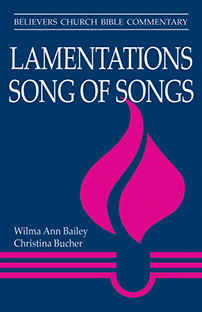Nuptial Imagery in the New Testament (in Song of Songs)
![]() Home A B C D E F G H I J K L M N O P Q R S T U V W X Y Z Abbreviations Glossary
Home A B C D E F G H I J K L M N O P Q R S T U V W X Y Z Abbreviations Glossary
Nuptial imagery and bride and bridegroom language are used of Jesus' earthly ministry in several gospel passages. For example, John the Baptist explains that he, himself, is only the friend of the bridegroom:
- The bride belongs to the bridegroom. The friend who attends the bridegroom waits and listens for him, and is full of joy when he hears the bridegroom's voice. That joy is mine, and it is now complete. (John 3:29)
In Mark 2:19–20 (and parallels), Jesus himself uses bride and bridegroom language in answer to a question about why Jesus' disciples do not fast as do other Jews:
- How can the guests of the bridegroom fast while he is with them? They cannot, so long as they have him with them. But the time will come when the bridegroom will be taken from them, and on that day they will fast.
Wedding imagery occurs in the parable of the wise and foolish maidens in Matthew 25:1–13. The parable exhorts Jesus' followers to remain faithful. In the parable, the bridegroom is delayed. The wise maidens are those who are prepared with oil for their lamps and able to welcome the bridegroom when he appears. An explicit exhortation occurs at the end of the parable: "Therefore keep watch, because you do not know the day or the hour" (25:13).
Ephesians 5:21–33 explicitly draws the analogy of husband and wife to Christ and the church. This analogy becomes one of the primary ways in which the Song is read allegorically by later Christians. In later Christian spiritual readings of the Song, the male is understood to be Christ. The identity of the female in the Song can shift. In ecclesiological readings, the female beloved is the church, as in Ephesians. In Christian mystical readings, the female is the "soul," the individual believer in relation to Christ. In the medieval period, Mariological readings come to the fore, in which the female in the Song of Songs is identified with Mary. It helps us understand this allegorical interpretation if we know that Mary, the mother of Jesus, was viewed in the medieval period as the "model Christian" and as a symbol of the church.
In the book of Revelation, nuptial imagery symbolizes the eschatological community of the faithful, who join in marriage to Christ, the Bridegroom. In chapter 18, the destruction of Babylon (i.e., Rome) is announced. This destruction is described as ending the joyful celebration that occurs at a wedding: "The voice of bridegroom and bride will never be heard in you [Babylon] again" (Rev 18:23b). Chapter 19 follows with a vision of Christ's victory, which is described with nuptial imagery:
- Then I heard what sounded like a great multitude, like the roar of rushing waters and like loud peals of thunder, shouting:
- "Hallelujah!
- For our Lord God Almighty reigns.
- Let us rejoice and be glad
- and give him glory!
- For the wedding of the Lamb has come,
- and his bride has made herself ready.
- Fine linen, bright and clean,
- was given her to wear." …
- Then the angel said to me, "Write this: Blessed are those who are invited to the wedding supper of the Lamb!" And he added, "These are the true words of God." (19:6–9)
In Revelation 21, three originally distinct images are brought together. The first two images occur in 21:2, where the visionary describes what he sees: "I saw the Holy City, the new Jerusalem, coming down out of heaven from God, prepared as a bride beautifully dressed for her husband." In this verse, the restored people of God are portrayed as a city, "the new Jerusalem," and as "a bride beautifully dressed for her husband." Later in the chapter, this bride's husband is called "the Lamb" (Rev 21:9). In this apocalyptic vision of John of Patmos, nuptial imagery joins with other imagery and language to figuratively describe the eschatological restoration of God's people.
| —Christina Bucher |
